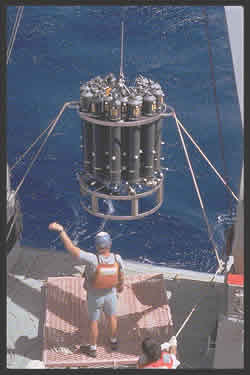| . | CTD and Tow Methods |
"CTD" is the abbreviated name for an instrument package that includes sensors for measuring the Conductivity, Temperature and Depth of seawater. The NOAA EOI Plume Studies Group uses a SeaBird 911plus CTD. The instrument is usually mounted within a frame, which also holds several bottles for sampling seawater along with a mechanism (usually called a "rosette" or "carousel") that allows scientists on board the ship to control when individual bottles are closed (figure right). The CTD is connected to the ship by means of a conducting cable and data are sent electronically through this cable, in real-time, to the scientists on the ship. The scientists closely monitor the data, looking for temperature and particle anomalies that identify hydrothermal plumes. They can send signals to the rosette via this cable when they want to close a bottle to obtain a water sample. A winch on the ship lowers and raises the CTD through the water. Seawater samples are retrieved from the bottles once the instrument package is brought back to the ship. Chemical and biological analyses of the seawater samples often occur on the ship, but some samples are preserved and stored for later analysis at a shore-based laboratory. Additional sensors (such as optical sensors for measuring particles), and instruments (such as the SUAVE chemical scanner) can also be mounted on the frame and interfaced with the CTD to measure additional properties of seawater. Optical sensors for measuring particle concentrations, such as the Sea Tech Transmissometer and Light Scattering Sensor (LSS), are very important in hydrothermal plume studies. Sampling Techniques: One standard oceanographic sampling technique is the vertical CTD cast. First, the scientists select a location of interest. The ship then travels to that position and stays as close to the same spot as possible depending on the weather and the ship’s basic capabilities) as the CTD package is lowered through the water, usually to within a few meters of the bottom, then raised back to the ship. The ship can then move to a different position and repeat the process. Hydrothermal plumes are typically located a few hundred meters above the ocean bottom, which over most of the world mid ocean ridge system averages 3000 meters deep. Therefore, much of the water overlying the hydrothermal vent fields is of little interest to the plume-hunting scientist. By lowering the CTD package to near the bottom, then moving the ship while cycling the package up and down only through the bottom few hundred meters, a far greater density of data can be obtained. This technique was dubbed a CTD "Tow-yo" and has proven to be an efficient and effective method for mapping and sampling hydrothermal plumes. |
||
| Hydrothermal
Plumes: What are hydrothermal plumes? | Why Study? | History | Study Areas | Methods |
||

 What
is a CTD?
What
is a CTD?